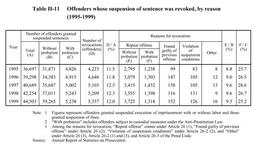| Previous Next Index Image Index Year Selection | |
|
|
5 Suspended sentence, etc. (1)Suspended sentence
Fig. II-6 shows trends in the suspended execution rate for offenders sentenced to determinate sentence imprisonment with or without labor in the last 10 years. Fig. II-6 Trends in suspended execution rate for offenders sentenced to determinate sentence imprisonment with or without labor (1990-1999) The suspended execution rate for imprisonment with labor remained between 50% and 60% until 1993 but has been above 60% since then. The suspended execution rate for imprisonment without labor, higher than that for imprisonment with labor, is more than 90% every year.On the first suspension of sentence, the decision as to whether the suspension should be conditional upon probation is left to the discretion of the court. For repeat cases, however, probation is mandatory. In 1999, 44, 016 offenders were given first suspended sentences (98.9% of all offenders given suspended sentences), of which 4,751 (10.7% of the same)were conditional upon probation. Repeat suspended sentences were given to 487 offenders (1.1% of the same). (2)Revocation of suspended sentence Table II-11 shows the number of offenders whose suspended sentence was revoked over the last5years, by reason for revocation. Table II-11 Offenders whose suspension of sentence was revoked, by reason (1995-1999) The number of offenders whose suspended sentence was revoked increased by 128 (2.5%) from the previous year to 5,337 in 1999. The overwhelmingly reason (94.5%) for revocation was that the offender committed a repeat offense and was consequently sentenced to imprisonment without labor, or a more severe punishment.The ratio of offenders granted suspension of sentence in a given year to offenders whose suspension of sentence was revoked in that year cannot strictly be called a"sentence suspension revocation ratio". This is because the two respective target groups are different. However, if we calculate this ratio in order to ascertain general trends concerning revocation of suspension, both the suspension revocation ratio (12.0%) and the suspension revocation ratio due to repeat offense (25.2%) continued to fall in 1999. By type of offense(limited only to those in which the total number of offenders granted suspended sentences and the number granted suspension with probation was at least 100), the suspension revocation ratio was high for Poisonous and Deleterious Substances Control Law violations (37.9%), Stimulant Drug Control Law violations (24.9%), and others. The revocation ratio due to repeat offense by adult probationers was high for Stimulant Drug Control Law violations (33.1%), larceny (30.9%), and others. |

